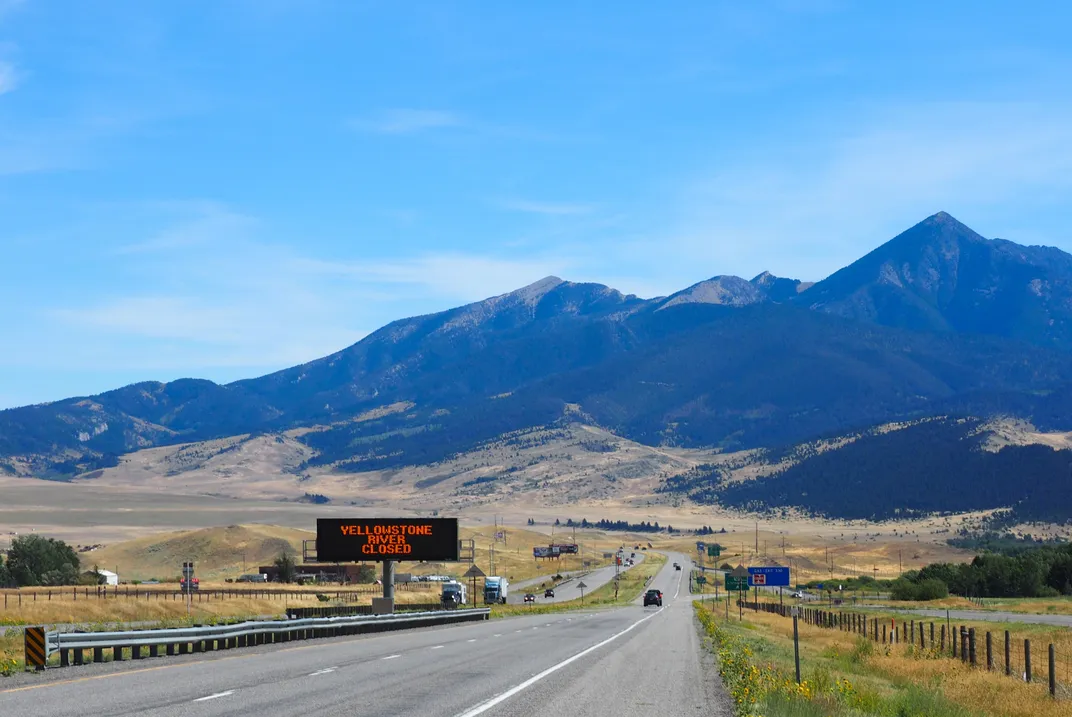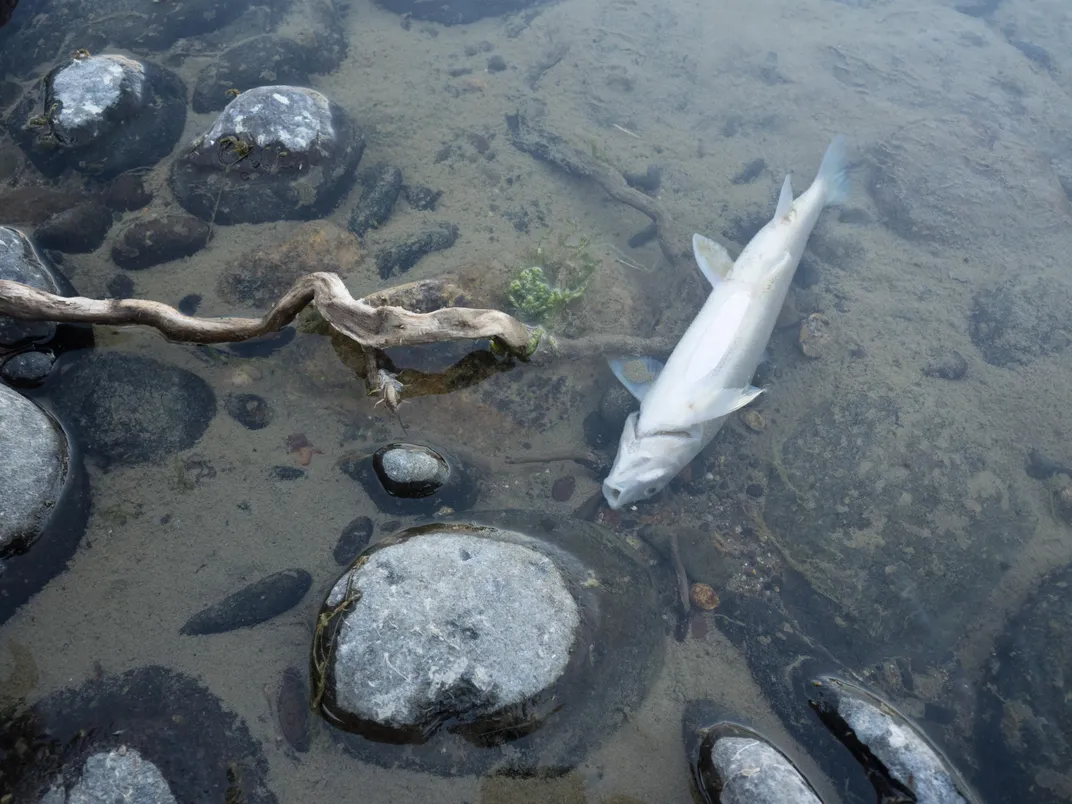The Massive Yellowstone Fish Die-Off: A Glimpse Into Our Climate Future?
This unprecedented kill reveals why we need to keep rivers resilient
/https://tf-cmsv2-smithsonianmag-media.s3.amazonaws.com/filer/73/85/7385d693-fb08-405a-98ac-aab4521714ee/fishkill4.jpg)
It was the kind of clear late-August day that anglers live for. Yet at the Yellowstone River near Livingston, Montana, not a single oar boat or even a fishing line broke the river’s calm surface. All was still, save for an osprey scavenging the corpses of pale, shimmering whitefish along the gravelly shoreline. A light breeze carried the sweetish smell of aquatic decay.
Earlier this month, the Yellowstone River made national headlines with the news of an unprecedented fish die-off in its usually healthy waters. Starting in mid-August, biologists counted 4,000 dead whitefish floating on the Yellowstone or washed ashore, but they estimate that the true number is in the tens of thousands. As if that wasn’t enough, they’ve recently spotted rainbow trout and Yellowstone cutthroat trout—both economically important species—go belly-up as well.
This devastating scene has state officials so worried that, on August 19, they closed a 183-mile stretch of the river and all of its tributaries until further notice. Fishing boats, inner tubers, even swimming dogs: none are allowed to get into the water.
The culprit is a tiny, highly contagious parasite called Tetracalsula bryosalmonae, which exclusively attacks fish. It worms its way into fishes’ kidneys, where it causes proliferative kidney disease and can obliterate fish populations, according to state biologists. (Science writer Ed Yong explains how this scientifically elusive parasite evolved from a jellyfish-like creature at The Atlantic.)
Those biologists note that it’s been a hot summer, and streamflows have been historically low—stressful conditions that make cold-adapted fish populations ripe for a deadly disease outbreak. The river closure is meant to keep the parasite out of other rivers and to keep fishers and boaters from further taxing sick fish.
“This is considered one of the worst parasites for salmonid fisheries in the U.S. and Europe,” says Eileen Ryce, a biologist overseeing hatcheries and fish health for Montana’s fish and wildlife agency. “It is a complicated parasite and we’ve got the perfect storm on the Yellowstone right now.”

The fish kill has shaken people in Livingston, a small river town of just over 7,000 people that is culturally and economically defined by its share of Montana’s $343-million dollar fishing industry.
Downtown at the bustling Katabatic Brewing Company, bartender Mark Lighthiser spent last Friday serving drinks to worried fishing guides who were already contemplating career changes. “We depend deeply on the Yellowstone as a resource—not just for water, but for recreation and our economy,” he says. Many here are worried that the fish kill is not a short-term hit, but a glimpse into what is to come if southwest Montana’s climate maintains its hotter and drier trajectory. “It’s not going to go away,” says Lighthiser.
This is a case of bad things happening to good rivers. The Yellowstone is the “Yankee Stadium” of fly-fishing, as one fisheries biologist quipped during a recent press conference. With its headwaters protected by Yellowstone National Park, the river has long remained a healthy bastion of native species, such as its nominal Yellowstone cutthroat trout. It’s also the longest river in the lower 48 states that has no reservoir taming its flows, thanks to efforts resisting a major dam proposal in the 1970s.
But as the recent whitefish kill shows, when the climate changes and pathogens proliferate into new regions, even healthy rivers like the Yellowstone are at risk.
Maintaining the river’s famous fishery requires constant vigilance—not only by the conservation community, but from everyone who sets a foot or drops a fly in the river. Biologists consider new pathogens or invasive species introductions to be one of the greatest threats to freshwater ecosystems. That’s why Montana’s fish and wildlife officials set up check stations for boats and educate anglers and boaters to vigilantly clean and inspect their boats, boots, and fishing waders.
For a long time, that program worked. Yet, whether by an angler’s boot or a bird’s foot, T. bryosalmonae slipped into the Yellowstone. Though the parasite has been found twice in the state in the last 20 years, this is the first time it’s caused a significant die-off.

News of the whitefish kill didn’t surprise Clint Muhlfeld, a U.S. Geological Survey aquatic ecologist and University of Montana researcher who studies climate change impacts on cold-water ecosystems. “We’re seeing severe impacts on Montana’s waters, mainly increases in stream temperatures and decreases in flows. These climate-induced changes are likely going to begin to interact with existing stressors such as habitat loss and invasive species,” he says. “The climate is warming, and there are going to be consequences for our freshwater ecosystems.”
Many Livingston residents are thinking along similar lines. “Climate change is the big gorilla in the room,” said Sweetwater Fly Shop owner Dan Gigone, who found himself rebooking clients and anticipating cancellations last weekend in the wake of the die-off. “I’m not a biologist, but my guess is that water temperatures played a big role in this. And if we continue to have lower snowpack in the winter and warmer temperatures in the summer these kinds of things are going to become more common.”
The good news is that trout and their relatives like whitefish already have experience with climate change. “These species, for the last 14,000 years have survived cataclysmic occurrences in the environment: flooding, wildfire, extremely warm temperatures, glaciation,” says Muhlfeld. “You name it, they’ve survived.”
But they’re still going to need a helping hand. Fortunately for the Yellowstone, conservation experts have been working for decades to provide the clean, complex and cold habitats that Muhlfield says are “key ingredients” for maintaining river ecosystems in a changing climate.
One crucial effort is restoring the Yellowstone’s higher-elevation side streams, so fish can use them as cold-water sanctuaries and spawning grounds. In 1970, Montana started changing its water laws to make it easier for the state, NGOs and irrigators to work together and keep water in streams and rivers. Those water-leasing policies and the creek restorations they allowed are a big reason why the Yellowstone hosts an abundance of its namesake cutthroat trout, says Patrick Byorth, who has worked on many Yellowstone restoration projects for the conservation group Trout Unlimited.
Conservationists on the Yellowstone are also working to insure the river against climate change by protecting its natural floodplain and meanders. Many landowners, fearing that erosion will turn their real estate into river silt, have stifled natural meandering by armoring the river’s banks with stone or metal. But natural floodplains have many ecological benefits, including sponge-like qualities that help bolster streamflows later in the dry season. A new program run by a Bozeman, Montana-based NGO is attempting to stave off armoring by paying landowners who choose to let the river naturally meander.
Thankfully, people can still do a lot to prepare rivers for disease introductions and other worst-case scenarios. That’s why biologists are optimistic that even the introduction of a new parasite isn’t necessarily a disastrous blow to the Yellowstone’s ecosystem. “You can’t hedge against catastrophe or a new pathogen finding its way into the population,” says Byorth. “What we can do is provide the healthiest river system possible so that when things like drought or diseases enter, you’ve created an environment where recovery can happen quickly and thoroughly.”
Byorth predicts: “You’ll see the Yellowstone bounce back.”